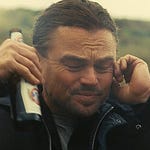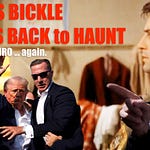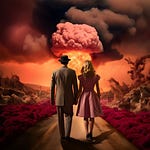It’s October, and it’s time to celebrate the best horror movies, at least in my opinion. I’m not the expert when it comes to horror. I have a few dozen I really love, but at the top of that list is Stanley Kubrick’s The Shining.
In 1980, just the trailer for Stanley Kubrick’s The Shining scared us. Everyone was talking about it. I was just 15. What did I know about movies? I didn’t know the name Stanley Kubrick, let alone Jack Nicholson. I don’t remember when I first saw The Shining, but it was probably not that year.
By the time I did see it, I was already fully immersed in the lore as everyone was going around bending their finger and pretending to talk like Danny talking to Tony. They were repeating Redrum, Redrum, Redrum. And of course, “Here’s Johnny.” What stood out to me when watching the movie finally was how smart Danny was to backtrack in a snowy maze to throw his father off track.
All these decades later, The Shining remains one of my favorite movies, and I watch it at least once a year, usually in October. The film has not lost a step in 45 years. Those who love it, obsess on it. Every detail is picked apart and dissected. How did he do that? How has it held its shape and magnetic force decade after decade?
What is it about this movie set in this particular place in this hotel that so fascinates us? It isn’t the book so much. It isn’t Stephen King’s imagination that we love. It’s how Stanley Kubrick brought it to life and the unusual, hammy, unforgettable performance of its star.
Do we see ourselves in Wendy? Do we imagine what if? Do we secretly desire to be trapped in that hotel all winter with all of that food in the freezer, the giant can of fruit cocktail, and no one around for miles? Does it sound like a dream or a nightmare? Would an only child want a whole hotel to himself to roam the hallways and dig into the mysteries?
Or is it that other layer, with the “shining” itself, the magical power the boy has, the one that Hallorann has?
I always knew the author of the book, Stephen King, wasn’t a fan of the movie. He said he liked some of it, but he felt Kubrick turned it into something else. He’s right. None of what most people remember about the movie, from Redrum to Here’s Johnny to the twins, “Come play with us, Danny…” is in the book.
The book is good in its own way and probably scarier and less funny than the movie. Stephen King has always been what we now call “woke.” He has always been aware of social justice and injustice, and he has woven it through his stories. His wife, Tabitha, was famously a feminist who has been schooling him ever since. That’s why the lead in his book, The Shining, is such a strong — albeit slightly annoying — female protagonist.
There is more to the story of the hotel itself in the book, including why it’s haunted and why it wants Danny due to his special powers. It’s also, I think, a scarier book because at the end, Hallorann (who isn’t murdered by Jack, as in the movie) is almost seduced by the evil of the hotel to kill Wendy and Danny, but he fights it off. I think that’s how it ends, though it’s been a while since I’ve read it.
Rewatching movies from the past is a reminder that movies didn’t use to judge or categorize characters in terms of their identity. Scatman Crothers is Halloran, and he is just Halloran.
Wendy is just a mom. Danny is just her son (with a supernatural ability). Jack, a stand-in for Stephen King in the book, is played by Jack Nicholson almost for laughs. That was Kubrick’s gift as a director - he could introduce absurd humor even if none existed in the source material.
The film isn’t a feminist screed, as there are evil forces in the hotel that take the shape of women, like the old lady in the bathtub and the twins. They don’t have to say anything about women or society. They can just exist as characters in a story.
Watching frail and scrawny Shelley Duvall crack her husband over the head with a bat is spectacular. Had they cast her with a stronger, more formidable actress to match the character in the book, they would have lost the character’s seemingly helpless quality. She is so small and the hotel is so big. That alone tells the story of this movie. We don’t think she can defeat her husband, and yet she does.
Everything about the movie is about showing the audience what it would be like to be stuck there, with all of the great things and the terrible things about it: you go stir crazy and try to murder your wife and child. Could you escape? If so, how?
Once you decide that everyone in the movie must make a grand statement about an entire population or gender, everything else the movie offers vanishes. When they tell you how to think and what to think, you don’t wonder. You stop asking questions. You don’t go deeper into the film.
There is no denying that it was a story conceived in the 1970s and released during a time when the country was changing and the pendulum was swinging. That might also be why so many of us ‘70s kids had the nightmare dad image stuck in our heads, since so many of our families had broken apart, marriages split up, and mothers were left to fend for the kids without them.
Whatever the dynamic at play, it has never alienated any generation over time because it wasn’t trapped in time. Kubrick was not trying to convey any message beyond the story of these three people trapped in a haunted hotel and how the mother and child barely escaped.
The Shining is pure cinema, from the saturated color of red, to the way the camera glides across the soundstage, to the hotel being surrounded by acres of white snow, to the fact that no one can get to them, and no one can get out. It is the imagery of Kubrick’s masterpiece that stays with us. He created an atmosphere that never feels artificial and yet, in its own way, feels entirely artificial.
He wasn’t the easiest director to work with, according to Shelley Duvall. But he was the kind of director that Hollywood no longer produces. They’ve become too fragile to function. Everything must go down easily. Their horror is increasingly grotesque and graphic, but their messaging must always be on point.
Much of what makes The Shining effective is how sound and music merge, allowing the dialogue to be minimal and much of the story to be absorbed through the senses. He wanted the viewer to feel the movie, to sense it, to taste it, to hear it — wheels on carpet, the distant sound of long-dead party goers, the hard hammer on the typewriter, and Jack pounds out All Work and No Play Makes Jack a Dull Boy, also not in the book.
So, when we rewatch The Shining, we aren’t so much watching to relive the story as to experience the movie with all our senses fully engaged. In that way. We feel like we’re a part of it, too. We are Wendy and Jack. We are Danny. We are Hallorann. And maybe we are the hotel. Maybe we are taking human behavior and turning it into our own entertainment for our own purposes.
The Shining is a great movie because Stanley Kubrick was a genius. He was fearless in what he sought to show us about human nature, as all great directors are. We don’t have films like this because we don’t have audiences like this. The Shining is a great way to remember some of the best Hollywood has ever produced, and a great way to kick off the month of October and the Halloween season.









